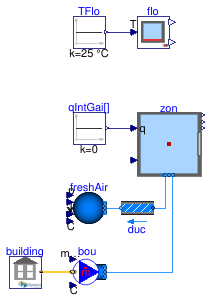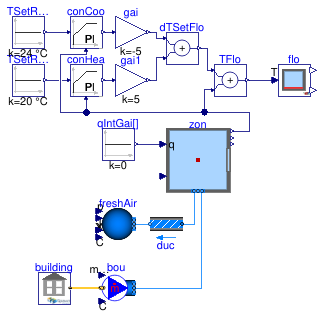Buildings.ThermalZones.EnergyPlus_9_6_0.Validation.ZoneSurface
Collection of validation models for EnergyPlus schedules
Information
This package contains validation models for EnergyPlus zone surfaces.
Extends from Modelica.Icons.Package (Icon for standard packages).
Package Content
| Name | Description |
|---|---|
| Validation model with one thermal zone with constant floor temperature | |
| Validation model with one thermal zone with controlled floor temperature |
 Buildings.ThermalZones.EnergyPlus_9_6_0.Validation.ZoneSurface.OneZoneConstantFloorTemperature
Buildings.ThermalZones.EnergyPlus_9_6_0.Validation.ZoneSurface.OneZoneConstantFloorTemperature
Validation model with one thermal zone with constant floor temperature

Information
Model that uses EnergyPlus and sets the floor temperature to a constant value.
When simulated, the heat flow rate at the floor is often around 10..20 Watts. However, it becomes negative when the direct solar irradiation is high, indicating that the net heat flow rate is from the room into the construction due to the solar gains that hit the floor even though the surface temperature is above the room air and room radiative temperature.
Extends from Buildings.ThermalZones.EnergyPlus_9_6_0.Examples.SingleFamilyHouse.Unconditioned (Example model with one unconditoned zone simulated in Modelica, and the other two unconditioned zones simulated in EnergyPlus).
Parameters
| Type | Name | Default | Description |
|---|---|---|---|
| Volume | VRoo | 453.1 | Room volume [m3] |
| MassFlowRate | m_flow_nominal | VRoo*1.2*0.3/3600 | Nominal mass flow rate [kg/s] |
Modelica definition
 Buildings.ThermalZones.EnergyPlus_9_6_0.Validation.ZoneSurface.OneZoneControlledFloorTemperature
Buildings.ThermalZones.EnergyPlus_9_6_0.Validation.ZoneSurface.OneZoneControlledFloorTemperature
Validation model with one thermal zone with controlled floor temperature

Information
Model that uses EnergyPlus and controls the floor temperature to a track a heating and cooling set point.
The model has two PI controllers, one for tracking the heating and and for tracking the cooling set point temperature. The model sets the surface temperature of the floor to provide heating or cooling if either control signal is non-zero. Note that this model assumes that the surface temperature can be perfectly controlled.
Extends from Buildings.ThermalZones.EnergyPlus_9_6_0.Examples.SingleFamilyHouse.Unconditioned (Example model with one unconditoned zone simulated in Modelica, and the other two unconditioned zones simulated in EnergyPlus).
Parameters
| Type | Name | Default | Description |
|---|---|---|---|
| Volume | VRoo | 453.1 | Room volume [m3] |
| MassFlowRate | m_flow_nominal | VRoo*1.2*0.3/3600 | Nominal mass flow rate [kg/s] |
